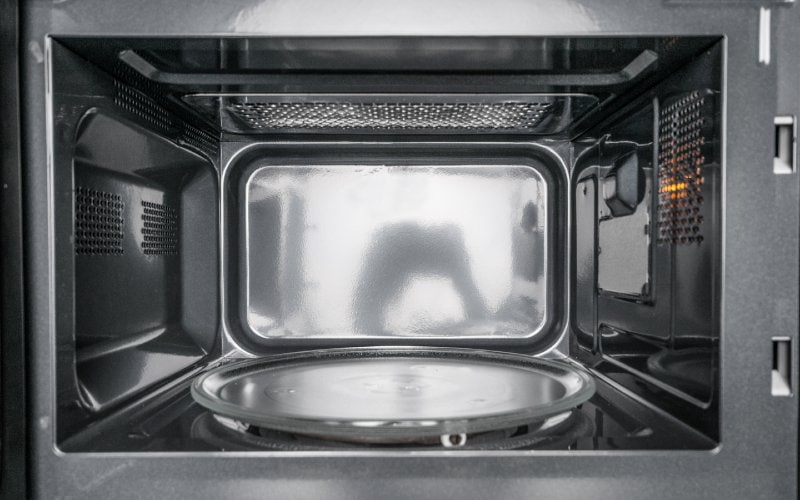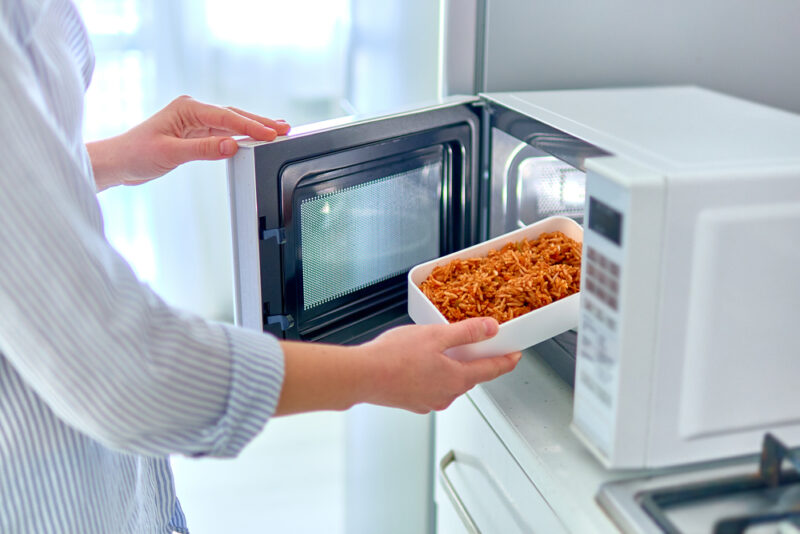How Does a Microwave Work? What You Need to Know!
-
Ed Malaker
- Last updated:
Microwave ovens are a fairly new method of cooking that has become extremely popular, and today, almost every home has one and uses it regularly. However, many people aren’t sure how they work, and there has been much mystery over the years, with some people worrying that they are dangerous.
Keep reading while we dive in to learn the facts, discuss how they work, and explain the advantages and disadvantages of these important cooking devices so you can be better informed.
How Do Microwaves Work?
Microwave ovens use a simple electrical component called a magnetron to produce microwaves that heat your food. The magnetron is essentially a long vacuum tube inside your microwave. It has a straight wire anode and a coaxial cathode, and when electricity runs between the two, it creates an electrical field that reacts with a powerful magnet sitting next to it. The reaction causes the component to act as an oscillator that can produce the high-frequency waves we need to heat our food. We also use magnetrons in radar systems.
Microwaves are shorter and higher pitched than radio waves but not as small as infrared waves. These waves bounce around inside the cooking chamber of your microwave oven and heat your food by exciting the molecules that make it up. They work especially well on food containing water, fat, and sugar as the waves become lodged in these materials. However, the small waves cannot penetrate too deeply into the food, so you must stir and mix it frequently to help distribute the heat.

What Are the Different Types of Microwave Ovens?
While there are many different microwave oven types, they all work the same and depend on the magnetron to create microwaves that heat the food. More powerful units can produce more microwaves and can heat more food faster. Some models will have a moving tray inside that can help distribute the heat more evenly, and many will give you access to timers and control over the heating power to help you heat food more consistently.
Where Is It Used?
You will find the microwave in almost every home in America. It’s also an important device in any home and fast-food establishment as it can heat many different foods quickly, saving space on the grill. You will also find microwaves in office break rooms and other non-traditional cooking locations, as they can help employees warm their lunch without requiring a difficult installation or dedicated fuel lines.

Advantages of a Microwave
There are many great advantages to owning and using a microwave oven. It can heat your food extremely quickly and will beat out your conventional stove or oven in many cases. It’s fairly inexpensive, especially compared to a range, and is easy and safe to use. You can use it to cook a wide variety of items, and many come prepackaged to make it easier to heat them in a microwave.
- Cooks a wide variety of items
- Inexpensive to purchase
- No fuel lines required
- Fast and convenient heating
Disadvantages of a Microwave
The disadvantage to using a microwave oven instead of a traditional range is that the microwave won’t penetrate deep into the food and usually only goes about 1–1.5 inches deep, so the inside can remain cold while the outside burns if you are not able to stir or mix it. It can also dry out many breads, making them hard, and it can turn many vegetables and other items into mush. It also uses a lot of power, might melt or leach harmful chemicals out of plastic, and if it is damaged or faulty, it can radiate harmful microwaves into the room.
- Microwaves only heat the surface of the food
- Power hungry
- Can dry out food or make it soggy
- May radiate microwaves into the room
Frequently Asked Questions
Is a microwave safe for children to use?
We recommend supervising your child when heating food using any device. However, compared to a traditional gas, or electric stove, a microwave is much safer to use and won’t likely result in any burns or fire damage. That said, the microwave oven can make food extremely hot, and it can cause burns as you try to remove it.

Do I need to preheat a microwave when I use it to reheat food?
No. There is no need to preheat the microwave and running it with no food inside might even cause damage. Simply set your food inside and set the timer and strength to reheat your food.
How do I know what bowls I can put in the microwave?
The best way to know if a bowl or cup is suitable for use in the microwave is to look it over carefully for the words “microwave safe.” If you don’t see the words and aren’t sure, you can try a simple test by placing the item in the microwave along with a half cup of water and running it on high for one minute. Once finished, if the item feels hot, you should not use it. If it’s warm, use it only to warm food quickly. However, if the item remains at room temperature, it is safe to use to heat your food.
In Conclusion
The microwave oven uses an electrical component called a magnetron to generate the microwaves that heat your food. The microwaves excite the molecules in the food, causing them to become hot. However, microwaves only penetrate a short distance into the food, so you will need to mix and turn the food frequently while heating to distribute the heat evenly.
You will also need to make sure the bowls, cups, and other items you place inside the oven are safe to use by looking them over carefully for the words “microwave safe” or by testing them yourself before putting them to use.
You might also like:
- Are Blender Bottles Microwave-Safe? (Microwave Safety Tips)
- Can You Microwave Solo Cups? (Microwave Safety Tips)
- Can You Microwave Paper Cups? Risks & Safety Tips
Featured Image Credit: Pixel-Shot, Shutterstock
Contents

